Tell us about the premise of Time and How to Spend It.
If you believe that we’re living in the ‘experience economy,’ then you’ll agree that our society is shifting from materialism to experientialism; that instead of looking for happiness and status in material things, we’re finding happiness and status in experiences instead.
In this post-materialist era of experiences, what you do now matters way more than what you have.
Do you see time as the new luxury?
There’s something really interesting here that no one’s noticed before: buying stuff requires money, but doing things takes time. Put those two together, and you come to a fascinating conclusion. The essential currency for buying happiness and signalling status has fundamentally changed. In the old age of materialism, it was money. But now, in the new era of experientialism, it’s time.
So, yes, time is the new luxury, as it’s the key currency for buying the things that matter most to us: happiness and status.
There’s another thought that follows from this. If knowing how to spend money was a sign of sophistication in the old world of values based on materialism, knowing how to spend time is an indicator of luxury status in the new world of values based on experientialism.
Why do you think people are misspending their time now?
People are misspending their time for three reasons:
First, weapons of mass distraction! Designed using all sorts of tricks and sleights of operant conditioning, we’re spending ridiculous amounts of our time looking at mobile phones, checking them like addicts. Ever seen a person checking their phone as they cross a road, while they’re on a sun lounger by the pool… there’s even data that suggests 10% of people check their phones during sex.
Some of the research author Adam Alter discovered in his book Irresistible is frightening: the average user checks their phone 150 times a day, extreme users 300 times a day. Imagine what that would have looked like in a world a hundred years ago, when the messaging system was the post: you’d have had to get up out of your seat, go to your front door to check if any mail had come through the letterbox… 150 times a day!
Second, the education system is focused on the skills of production: we want a practical degree, we want to learn how to do online marketing, we want an MBA. Too much of our education system is based on ‘how to be more productive and effective at work’. Who takes a course in ‘how to spend your time to maximise your happiness and wellbeing’?
Third, we’re so busy at work, we multitask, even though we know we shouldn’t and even though it takes 23 minutes to refocus after every distraction. The real problem here is because we multitask at work, we’re now doing it in our free time. As Brigid Schulte discovered in her brilliant book Overwhelmed, sociologists call this ‘contaminated time’. Although we think we’re getting more from our precious time, it makes us feel time-crunched. Not smart, not good for happiness.
What is Experience Intelligence? And how do you achieve it?
‘Experience intelligence’ reflects some of the fascinating discoveries made by social scientists in recent years. These discoveries strongly suggest that, just as you need general intelligence and emotional intelligence to be successful, so you also need ‘experience intelligence’. As well as IQ and EQ, in other words, you also need XQ.
Here’s why. On the one hand, as social scientists like Sonja Lyubomirsky at the University of California and Shawn Achor at Harvard have discovered, if you want to be successful, you should first seek to be happy. On the other hand, as other researchers like Elizabeth Dunn at the University of British Columbia and Tom Gilovich at Cornell have found, if you want to happy, you should spend your money on experiences rather than things.
What are the benefits of Experience Intelligence?
Put those two discoveries and you arrive at a simple equation: experiences lead to happiness, happiness leads to success, so experiences lead to success.
Once you recognise this, it highlights a new question: what kind of experiences are most likely to lead to happiness and success? Just as there’s empty calories and ‘super’ foods, so some of the things we do are the experience equivalent of highly processed, high corn syrup content fast food –and some are as good for us as kale, broccoli and blueberries.
The way to increase your experience intelligence is following the 7 rules in Time And How To Spend It. For instance, do things that are intense and challenging, like going bouldering or kayaking. Learn something new, like how to make genuine pad Thai, or how to play the guitar. Or do something for someone else this weekend: go have a cup of tea with your lonely neighbor, or simply help out a friend.
Connecting this to wider consumer trends, do you think we are at an inflection point where people generally are having a crisis of meaning?
We’re questioning what matters. Turns out, the system we live in is noxious for the planet, for our communities, for our bodies, for our physical and mental health. People are wondering, ‘What happened to better?’
So, whenever we look up from our devices and stop internet shopping for more than a moment, we’re open to something else.
And now we know how data can set our businesses free, once the data’s been turned into meaning, we’re open – I think – to people like Cal Newport and Adam Alter and me translating all the data the scientists are crunching into practical ideas we can apply to be happier, healthier, more successful.
Do you think we’re at a tipping point in people’s consumption of digital media and communication?
I’m not sure. There are signs, but let’s not forget how freaking awesome technology and digital media is. A tiny device that contains answers to so many questions, connects you with your wife and your work, shows you The Office (because who doesn’t love Dwight Schrute, right?), takes great pictures of your kids, and takes your entire music with you to the beach/park etc. These things are great. We won’t bin digital communications. Too late. The horse has bolted. We just need to learn to live with them.
And we will. It’s like any addictive substance or practice: use not abuse, laws if necessary.
What can brands learn from the message of your book?
Experience first! The question brands should be asking is inspired by Maya Angelou:
“People will forget what you said, people will forget what you did, but people will never forget how you made them feel.”
How will you make them feel is the same as asking: what sort of experience will they have when they deal with you?
But don’t just use simple customer journey mapping, and jobs-to-be-done (JTBD) theory – both are useful but not nearly enough. Instead, you should be thinking about person / life mapping. To do that, you need to understand the hero’s journey, and how every one of your customers, clients, suppliers, partners etc. are on their own hero’s journey.
Borrowing from Kurt Vonnegut, Joseph Campbell, Christopher Vogler and Yuval Noah Harari, you can see how everyone is on their hero’s journey and why this is essential to understanding humans. Every interaction with your brand is part of their journey, so understanding how you can be a test, an enemy, an ally, or a mentor is essential.
It’s much deeper than JTBD theory. It looks at a longer journey than simple customer journey mapping. And it’s harder to make sense of this. But if you get this right, you’re on the way to helping them become a hero and have a chance to be a more important of their journey.



